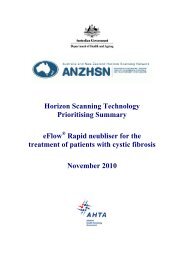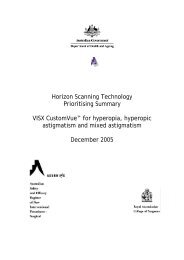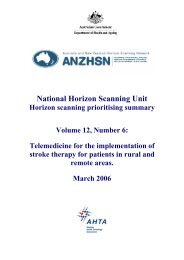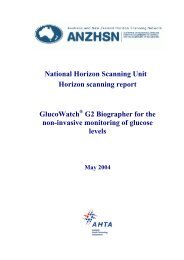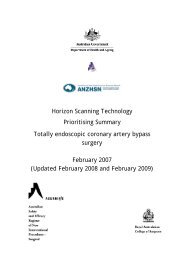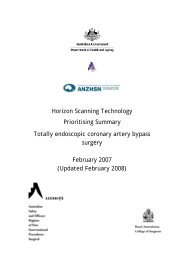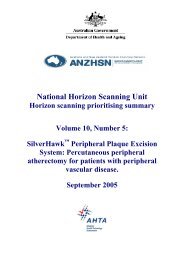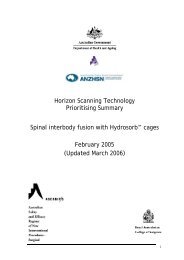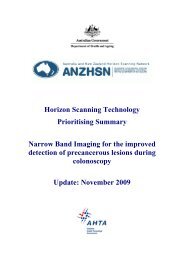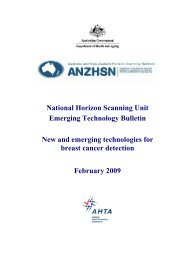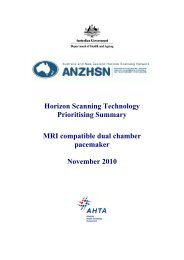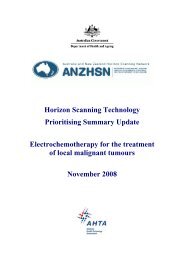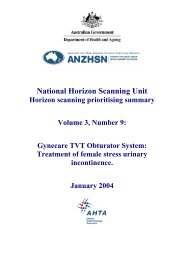an accommodating intraocular lens replacement for patients
an accommodating intraocular lens replacement for patients
an accommodating intraocular lens replacement for patients
You also want an ePaper? Increase the reach of your titles
YUMPU automatically turns print PDFs into web optimized ePapers that Google loves.
National Horizon Sc<strong>an</strong>ning Unit<br />
Horizon sc<strong>an</strong>ning prioritising summary<br />
Volume 6, Number 3:<br />
CrystaLens : An <strong>accommodating</strong><br />
<strong>intraocular</strong> <strong>lens</strong> <strong>replacement</strong> <strong>for</strong> <strong>patients</strong><br />
with cataracts.<br />
August 2004
© Commonwealth of Australia 2005<br />
This work is copyright. You may download, display, print <strong>an</strong>d reproduce this material in<br />
unaltered <strong>for</strong>m only (retaining this notice) <strong>for</strong> your personal, non-commercial use or use<br />
within your org<strong>an</strong>isation. Apart from <strong>an</strong>y use as permitted under the Copyright Act 1968, all<br />
other rights are reserved. Requests <strong>an</strong>d inquiries concerning reproduction <strong>an</strong>d rights should be<br />
addressed to Commonwealth Copyright Administration, Attorney General’s Department,<br />
Robert Garr<strong>an</strong> Offices, National Circuit, C<strong>an</strong>berra ACT 2600 or posted at<br />
http://www.ag.gov.au/cca<br />
Electronic copies c<strong>an</strong> be obtained from http://www.horizonsc<strong>an</strong>ning.gov.au<br />
Enquiries about the content of this summary should be directed to:<br />
HealthPACT Secretariat<br />
Department of Health <strong>an</strong>d Ageing<br />
MDP 106<br />
GPO Box 9848<br />
C<strong>an</strong>berra ACT 2606<br />
AUSTRALIA<br />
DISCLAIMER: This summary is based on in<strong>for</strong>mation available at the time of research <strong>an</strong>d<br />
c<strong>an</strong>not be expected to cover <strong>an</strong>y developments arising from subsequent improvements to<br />
health technologies. This summary is based on a limited literature search <strong>an</strong>d is not a<br />
definitive statement on the safety, effectiveness or cost-effectiveness of the health technology<br />
covered.<br />
The Commonwealth does not guar<strong>an</strong>tee the accuracy, currency or completeness of the<br />
in<strong>for</strong>mation in this summary. This summary is not intended to be used as medical advice <strong>an</strong>d<br />
it is not intended to be used to diagnose, treat, cure or prevent <strong>an</strong>y disease, nor should it be<br />
used <strong>for</strong> therapeutic purposes or as a substitute <strong>for</strong> a health professional's advice. The<br />
Commonwealth does not accept <strong>an</strong>y liability <strong>for</strong> <strong>an</strong>y injury, loss or damage incurred by use of<br />
or reli<strong>an</strong>ce on the in<strong>for</strong>mation.<br />
The production of this Horizon sc<strong>an</strong>ning prioritising summary was overseen by the Health<br />
Policy Advisory Committee on Technology (HealthPACT), a sub-committee of the Medical<br />
Services Advisory Committee (MSAC). HealthPACT comprises representatives from health<br />
departments in all states <strong>an</strong>d territories, the Australia <strong>an</strong>d New Zeal<strong>an</strong>d governments; MSAC<br />
<strong>an</strong>d ASERNIP-S. The Australi<strong>an</strong> Health Ministers’ Advisory Council (AHMAC) supports<br />
HealthPACT through funding.<br />
This Horizon sc<strong>an</strong>ning prioritising summary was prepared by Linda Mundy from the National<br />
Horizon Sc<strong>an</strong>ning Unit, Adelaide Health Technology Assessment, Department of Public<br />
Health, Mail Drop 511, University of Adelaide, South Australia, 5005.
REGISTER ID: 000107<br />
PRIORITISING SUMMARY<br />
NAME OF TECHNOLOGY:<br />
CRYSTALENS<br />
PURPOSE AND TARGET GROUP:<br />
AN ACCOMMODATING INTRAOCULAR LENS<br />
REPLACEMENT FOR PATIENTS WITH CATARACTS<br />
STAGE OF DEVELOPMENT (IN AUSTRALIA):<br />
Yet to emerge Established<br />
Experimental Established but ch<strong>an</strong>ged indication<br />
or modification of technique<br />
Investigational Should be taken out of use<br />
⌧<br />
Nearly established<br />
AUSTRALIAN THERAPEUTIC GOODS ADMINISTRATION APPROVAL<br />
⌧ Yes ARTG number 96278<br />
No Not applicable<br />
The CrystaLens device is listed on the Australi<strong>an</strong> Register of Therapeutic Goods <strong>an</strong>d<br />
received approval from the United States Food <strong>an</strong>d Drug Administration in November 2003.<br />
INTERNATIONAL UTILISATION:<br />
Germ<strong>an</strong>y<br />
United States<br />
COUNTRY<br />
Trials Underway or<br />
Completed<br />
<br />
<br />
LEVEL OF USE<br />
Limited Use<br />
Widely Diffused<br />
IMPACT SUMMARY:<br />
CrystaLens is m<strong>an</strong>ufactured by eyeonics incorporated <strong>an</strong>d is distributed by Concept Vision<br />
Australia Pty Ltd. CrystaLens is <strong>an</strong> <strong>intraocular</strong> <strong>lens</strong> (IOL) intended <strong>for</strong> visual correction in<br />
<strong>patients</strong> in whom a cataractous <strong>lens</strong> has been removed. It is a multi-focal IOL, intended to<br />
provide near, intermediate <strong>an</strong>d dist<strong>an</strong>t vision without the aid of spectacles. The technology is<br />
available through ophthalmologists in public <strong>an</strong>d private practice.<br />
BACKGROUND<br />
The <strong>lens</strong> is responsible <strong>for</strong> focusing light <strong>an</strong>d producing clear, sharp images. It is contained in<br />
a capsule <strong>an</strong>d as old cells die they accumulate in the capsule, causing the <strong>lens</strong> to cloud (a<br />
cataract), making images blurred (Figure 1).<br />
Cataracts may affect individuals of <strong>an</strong>y age, however they usually occur as a part of the<br />
natural ageing process <strong>an</strong>d predomin<strong>an</strong>tly occur in people over 50 years of age. Cataracts may<br />
occur in one or both eyes <strong>an</strong>d c<strong>an</strong> develop as a result of injury or eye disease, or may occur as<br />
a complication of other diseases such as diabetes. Exposure to cigarette smoking <strong>an</strong>d sunlight<br />
increase the risk of developing cataracts (Royal Australi<strong>an</strong> <strong>an</strong>d New Zeal<strong>an</strong>d College of<br />
Ophthalmologists 2004).<br />
1
A<br />
B<br />
Figure 1<br />
A: In a normal eye the cornea <strong>an</strong>d the <strong>lens</strong> focus light rays onto the retina<br />
B: Lens with a cataract, blocking the light rays so the eyesight is reduced<br />
(Printed with permission, The Children's Hospital at Westmead, Sydney Children's Hospital,<br />
R<strong>an</strong>dwick & Kaleidoscope Hunter Children's Health Network)<br />
Mild cataracts may be treated with a ch<strong>an</strong>ge in prescription glasses, however more serious<br />
symptoms need to be treated by the surgical removal of the cataract <strong>an</strong>d the impl<strong>an</strong>tation of<br />
either a mono- or multi-focal intra-ocular <strong>lens</strong> (Royal Australi<strong>an</strong> <strong>an</strong>d New Zeal<strong>an</strong>d College of<br />
Ophthalmologists 2004).<br />
The CrsytaLens is m<strong>an</strong>ufactured from high-refractive, non-reflective silicone, which<br />
contains a UV filter. The <strong>lens</strong> consists of a hinged plate with a relatively small biconvex optic<br />
<strong>an</strong>d is fixed to the capsular bag by polyimide loops (Figure 2). The hinged plate enables<br />
maximum posterior positioning of the <strong>lens</strong> in the capsular bag, allowing <strong>for</strong> greater <strong>for</strong>ward<br />
movement of the <strong>lens</strong> when the ciliary body 1 constricts. Anteroposterior movement of the <strong>lens</strong><br />
along the axis of the eye provides near, intermediate <strong>an</strong>d dist<strong>an</strong>t vision. The total length of the<br />
<strong>lens</strong> is 11.5 mm from loop-to-loop, while the length measured from the ends of the plate<br />
haptics is 10.5 mm (Breen et al 2001; Cumming et al 2001). The use of CrystaLens may be<br />
contraindicated in <strong>patients</strong> whose pupils widely dilate in low levels of illumination due to the<br />
small size of the biconvex optic (Colvard 2004).<br />
Hinge<br />
4.5mm optic<br />
Polyimide loops<br />
Figure 2<br />
The Crysta<strong>lens</strong> AT-45 <strong>accommodating</strong> <strong>intraocular</strong> <strong>lens</strong> (Printed with permission,<br />
eyeonics)<br />
CLINICAL NEED AND BURDEN OF DISEASE<br />
In Australia, there are 36,000 people with vision impairment due to cataract (Vision Australia<br />
Foundation 2004) <strong>an</strong>d cataracts account <strong>for</strong> approximately eight per cent of blindness (Lions<br />
Eye Institute 2003). The rate of cataract surgery doubles with each decade of life, from<br />
approximately 0.5 per cent of individuals aged 40 years to approximately 50 per cent of those<br />
in their 90s (Vision Australia Foundation 2004). The Australi<strong>an</strong> Institute of Health <strong>an</strong>d<br />
Welfare reports that the total number of Australi<strong>an</strong> public hospital separations <strong>for</strong> senile<br />
cataracts <strong>an</strong>d other cataracts (AR-DRG numbers H25 <strong>an</strong>d H27) were 137,662 <strong>an</strong>d 352, 678<br />
1 The ciliary body is the thickened part of the vascular portion of the eye, which lies between the iris<br />
<strong>an</strong>d the choroid. It produces the aqueous humour, which circulates in the chambers of the eye (Merck,<br />
Sharp <strong>an</strong>d Dohme 2004).<br />
2
espectively during the year 2001-02 (AIHW 2004). Approximately 60% of these separations<br />
were female, which may reflect the gender imbal<strong>an</strong>ce in the ageing population.<br />
DIFFUSION<br />
Concept Vision are in the process of conducting a controlled roll-out of their product,<br />
Crysta<strong>lens</strong>, in Australia. This involves training ophthalmologists in patient selection, as<br />
well as in to the technique used <strong>for</strong> impl<strong>an</strong>ting the <strong>lens</strong>. Currently 250 CrystaLens <strong>lens</strong>es<br />
have been impl<strong>an</strong>ted in Australia. There have been approximately 25,000 CrystaLens<br />
<strong>lens</strong>es impl<strong>an</strong>ted in Europe <strong>an</strong>d 10,000 impl<strong>an</strong>ted in the USA since FDA approval in<br />
November 2003 (personal communication, Concept Vision Australia).<br />
COMPARATORS<br />
Cataracts causing only mild symptoms may not need treatment. Some individuals may<br />
experience ch<strong>an</strong>ges in their eyesight due to the presence of cataracts, which may be remedied<br />
by the provision of a new prescription <strong>for</strong> glasses. If the symptoms of cataracts are more<br />
serious, then the only option is the surgical removal of the cataract followed by the<br />
impl<strong>an</strong>tation of <strong>an</strong> either a monofocal or multifocal IOL. Monofocal IOLs have a fixed<br />
refractive power <strong>an</strong>d there<strong>for</strong>e a fixed focal length, me<strong>an</strong>ing that most <strong>patients</strong> will require<br />
reading glasses <strong>for</strong> near vision. Multifocal IOLs may give a two to three fold increase in the<br />
depth of field but this is achieved at the expense of <strong>an</strong> approximate 50 per cent reduction in<br />
the contrast of the retinal image. Multifocal IOLs are effective at improving near vision<br />
compared to monofocal IOLs <strong>an</strong>d may give independence from spectacles, however a number<br />
of adverse effects are associated with multifocal IOLs, such as haloes, or rings around lights<br />
(Leyl<strong>an</strong>d & Zinicola 2002).<br />
EFFECTIVENESS AND SAFETY ISSUES<br />
A pre-clinical case series study (Level IV evidence) of the CrystaLens device was<br />
conducted by eyeonics inc <strong>for</strong> submission to the United States FDA. Pre-impl<strong>an</strong>tation visual<br />
acuity values were not reported <strong>for</strong> <strong>patients</strong> enrolled in this study, only visual acuity values<br />
post-impl<strong>an</strong>tation with CrystaLens, there<strong>for</strong>e it is impossible to determine the effectiveness<br />
of this procedure. A further study, conducted by eyeonics inc compared <strong>patients</strong> impl<strong>an</strong>ted<br />
with the CrystaLens (n=126) to those impl<strong>an</strong>ted with a variety of st<strong>an</strong>dard IOLs (n=64). No<br />
pre-impl<strong>an</strong>tation visual acuity scores were reported <strong>for</strong> <strong>patients</strong> in either group, however the<br />
number of adverse events in the group impl<strong>an</strong>ted with CrystaLens was reported. Adverse<br />
events included persistent iritis (
The current cost of multifocal or monofocal IOLs is approximately $200 <strong>an</strong>d $180,<br />
respectively (personal communication, Adv<strong>an</strong>ced Medical Optics Australia Pty Ltd).<br />
ETHICAL, CULTURAL OR RELIGIOUS CONSIDERATIONS<br />
No issues were identified/raised in the sources examined.<br />
OTHER ISSUES<br />
The authors of the White paper <strong>an</strong>d the authors of the paper 'Clinical evaluation of the model<br />
AT-45 silicone <strong>accommodating</strong> <strong>intraocular</strong> <strong>lens</strong>: results of feasibility <strong>an</strong>d the initial phase of<br />
a Food <strong>an</strong>d Drug Administration clinical trial', all have commercial interests in the<br />
CrystaLens <strong>intraocular</strong> <strong>lens</strong>.<br />
CONCLUSION:<br />
There is limited case series evidence currently available <strong>an</strong>d reported results lack<br />
st<strong>an</strong>dardisation.<br />
HEALTHPACT ACTION:<br />
There<strong>for</strong>e it is recommended that this technology be archived.<br />
SOURCES OF FURTHER INFORMATION:<br />
Breen, M. J., Cumming, J. S. & Kramsky, P. S. (2001). The C&C vision CrystaLens (TM)<br />
model AT-45 silicone multipiece <strong>intraocular</strong> <strong>lens</strong>. (White paper), C & C Vision, Cali<strong>for</strong>nia.<br />
Colvard, M. (2004). Moving <strong>for</strong>ward with the CrystaLens [Internet]. Review of<br />
Ophthalmology. Available from: http://www.revophth.com/index.asppage=1_453.htm<br />
[Accessed 26th July 2004].<br />
Cumming, J. S., Slade, S. G. & Chayet, A. (2001). 'Clinical evaluation of the model AT-45<br />
silicone <strong>accommodating</strong> <strong>intraocular</strong> <strong>lens</strong>: results of feasibility <strong>an</strong>d the initial phase of a Food<br />
<strong>an</strong>d Drug Administration clinical trial', Ophthalmology, 108 (11), 2005-2009; discussion<br />
2010.<br />
EyeWorld, The Americ<strong>an</strong> Society of Cataract <strong>an</strong>d refractive Surgery (2002). Accommodative<br />
IOLs coming a long way [Internet]. Available from:<br />
http://www.eyeworld.org/mar02/0302p18.html [Accessed 26th July 2004].<br />
Food <strong>an</strong>d Drug Administration (2004a). Summary of safety <strong>an</strong>d effectiveness data-<br />
CrystaLens [Internet]. Available from: http://www.fda.gov/cdrh/pdf3/P030002b.pdf<br />
[Accessed 26th July 2004].<br />
Food <strong>an</strong>d Drug Administration (2004b). Physici<strong>an</strong> labelling – CrystaLens [Internet].<br />
Available from: http://www.fda.gov/cdrh/pdf3/P030002c.pdf [Accessed 26th July 2004].<br />
Leyl<strong>an</strong>d, M. & Zinicola, E. (2002). Multifocal versus monofocal <strong>intraocular</strong> <strong>lens</strong>es after<br />
cataract extraction (Cochr<strong>an</strong>e Review), The Cochr<strong>an</strong>e Library, Chichester.<br />
Lions Eye Institute (2003). Cataract fact sheet [Internet]. Available from:<br />
http://www.lei.org.au/docs/Cataract.pdf [Accessed 26th July 2004].<br />
Merck, Sharp <strong>an</strong>d Dohme (2004). Basic Anatomy – The eye [Internet]. Available from:<br />
http://www.mercksharpdohme.com/disease/glaucoma/the_eye/<strong>an</strong>atomy/ciliary.html#eye,<br />
[Accessed 9 th August 2004].<br />
Optometrist Australia (2004). [Internet]. Available from: http://www.optometrist.com.au<br />
[Accessed 27 th July, 2004].<br />
Sydney Children’s Hospital (2004). Congenital Cataracts Fact Sheet [Internet]. Available<br />
from: http://www.chw.edu.au/parents/factsheets/pdf/congenital_cataracts.pdf [Accessed 26th<br />
July 2004].<br />
4
Vision Australia Foundation (2004). How common is cataract [Internet]. Available from:<br />
http://www.visionaustralia.org.au/index.aspinc=&parentnav=vision&childnav=cataract&sub<br />
section=common&topnav=cataract&float= [Accessed 26 th July 2004].<br />
SEARCH CRITERIA TO BE USED:<br />
Lasers/diagnostic use<br />
*Lens Impl<strong>an</strong>tation, Intraocular<br />
*Lenses, Intraocular<br />
Presbyopia/surgery<br />
Prosthesis Design<br />
Pseudophakia<br />
Phacoemulsification<br />
*Silicone Elastomers<br />
Visual Acuity/physiology<br />
APPENDIX<br />
20/20 vision is a term used to describe normal dist<strong>an</strong>ce vision. The ‘20’ represents a dist<strong>an</strong>ce<br />
of 20 feet, the st<strong>an</strong>dard testing dist<strong>an</strong>ce used by optometrists. In metric countries such as<br />
Australia vision may be described as 6/6, where the six represents 6 metres. If <strong>an</strong> individual is<br />
described as having 20/40 vision, then that person must st<strong>an</strong>d at 20 feet to see what a person<br />
with normal vision c<strong>an</strong> see at 40 feet. 20/200 vision is the cut off <strong>for</strong> legal blindness.<br />
Conversely, <strong>an</strong> individual with 20/10 vision has above normal vision (Optometrist Australia,<br />
2003).<br />
5



